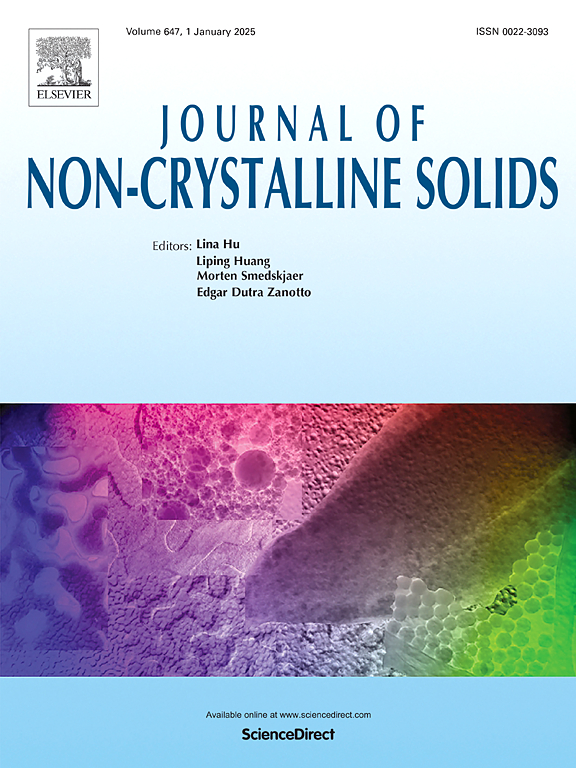一种利用过冷大块金属玻璃超塑性的TiAl/GH4099连接新策略
IF 3.5
3区 材料科学
Q1 MATERIALS SCIENCE, CERAMICS
引用次数: 0
摘要
大块金属玻璃(bmg)由于其无缺陷的原子结构,在过冷液体区表现出超高强度、超高硬度和超塑性等独特性能。在本研究中,利用bmg的超塑性来实现高温合金之间的高强度结合。采用真空压铸工艺制备了0.5 mm厚的Ni62Nb38非晶夹层,用于TiAl和GH4099合金的连接。结果表明,与传统的单辊熔融纺丝制备的非晶带状焊料相比,真空压制制备的中间层具有更好的稳定性和性能一致性。通过x射线衍射(XRD)、扫描电子显微镜(SEM)、透射电子显微镜(TEM)和选择区域电子衍射(SAED)技术分析了过冷液区界面孔隙的收缩行为,以及随后的原子扩散和高温下的微观结构演变。研究结果表明形成了一个坚固的冶金键,其中接头由γ-TiAl/Ti₃Al/AlNi₂Ti/NiNb和Ni₃Nb/γ-Ni相组成。在室温和750℃下进行剪切试验来评估结合强度,结果表明,在室温下,接头的抗剪强度可达315 MPa,在750℃下可达250 MPa。本文章由计算机程序翻译,如有差异,请以英文原文为准。
A Novel TiAl/GH4099 joining strategy utilizing the superplasticity of undercooled bulk metallic glass
Bulk metallic glasses (BMGs) exhibit unique properties, including ultra-high strength, exceptional hardness, and superplasticity in the supercooled liquid region, due to their defect-free atomic structure. In this study, the superplasticity of BMGs was exploited to achieve high-strength bonding between high-temperature alloys. A 0.5 mm-thick Ni62Nb38 amorphous interlayer was fabricated using vacuum die-casting technology and employed for joining TiAl and GH4099 alloys. The results demonstrated that the interlayer produced via vacuum pressing exhibited superior stability and performance consistency compared to the amorphous ribbon solder prepared by conventional single-roll melt spinning. The shrinkage behavior of interfacial pores in the supercooled liquid region, along with the subsequent atomic diffusion and microstructural evolution at elevated temperatures, was analyzed via X-Ray Diffraction (XRD), Scanning Electron Microscope (SEM), Transmission Electron Microscope (TEM), and selected area electron diffraction (SAED) techniques. The findings revealed the formation of a robust metallurgical bond, where the joint consists of the γ-TiAl/Ti₃Al/AlNi₂Ti/NiNb and Ni₃Nb/γ-Ni phases. Shear tests performed at room temperature and 750 °C were employed to assess the bonding strength, revealing that the joint achieved shear strengths of up to 315 MPa at room temperature and 250 MPa at 750 °C.
求助全文
通过发布文献求助,成功后即可免费获取论文全文。
去求助
来源期刊

Journal of Non-crystalline Solids
工程技术-材料科学:硅酸盐
CiteScore
6.50
自引率
11.40%
发文量
576
审稿时长
35 days
期刊介绍:
The Journal of Non-Crystalline Solids publishes review articles, research papers, and Letters to the Editor on amorphous and glassy materials, including inorganic, organic, polymeric, hybrid and metallic systems. Papers on partially glassy materials, such as glass-ceramics and glass-matrix composites, and papers involving the liquid state are also included in so far as the properties of the liquid are relevant for the formation of the solid.
In all cases the papers must demonstrate both novelty and importance to the field, by way of significant advances in understanding or application of non-crystalline solids; in the case of Letters, a compelling case must also be made for expedited handling.
 求助内容:
求助内容: 应助结果提醒方式:
应助结果提醒方式:


